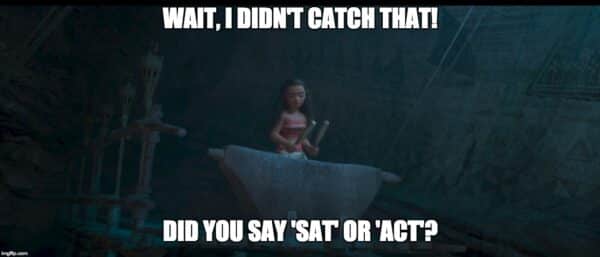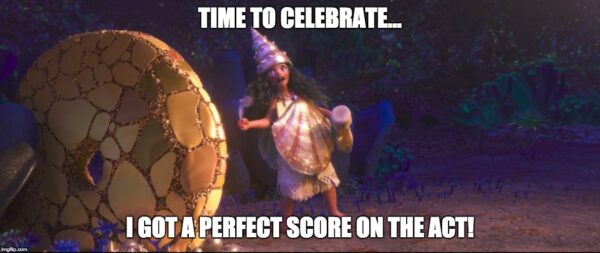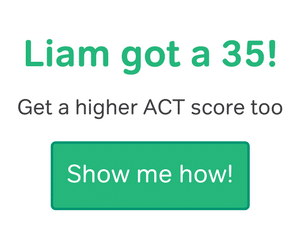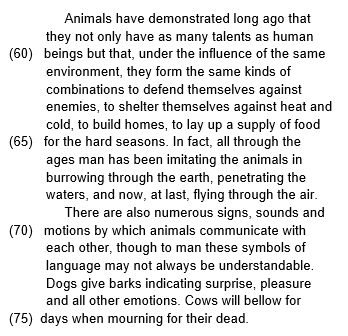If you’ve been working on the ACT Reading section (or if it’s entirely new to you), you may take a look at the test and think:

But it doesn’t have to be!
I don’t know if you noticed this when watching Moana, but the same ten principles that guide the heroine on her journey are exactly the same principles that you’ll need to master ACT Reading.
Crazy, right?
So break out beyond the reef, Wayfinders, and join me for the journey to a perfect score!
Table of Contents
- Don’t Freak Out: The Least You Should Know About ACT Reading
- Don’t Get Distracted by the Shark Head: Timing on ACT English
- Know Where You Are: Scoring on ACT Reading
- Listen to the Drum: ACT Reading vs SAT Reading
- Learn How to Sail: Skills Tested in the ACT Reading Section
- Their Boat Is Turning Into More Boats!: Question Types on the ACT Reading Test
- Get a Magic Manta Ray Grandma: How to Read on ACT Reading
- The ACT Reading Quiz
- Beware Pirates in Disguise: Struggles on the ACT Reading Test
- Don’t Throw Yourself Against the Rocks: Guide to Improving Your ACT Reading Score 2, 4, or 6 Points
- Sparkle, Sparkle, Sparkle: How to Get a Perfect 36 on the ACT Reading Test
- Get an Indestructible Chicken: Where Can I Find More Examples/Resources?
How to Use This Post
There’s a ton of information for you here—so let’s make the most of our time together.
If you’re entirely new to ACT Reading, start out with The Least You Should Know About ACT Reading. Then, it’s worth your while to take a look at Timing on ACT Reading and Scoring on ACT Reading as well. You might want to turn to an ACT diagnostic test to get a sense of your own strengths and weaknesses before moving on.
If you have some experience with ACT Reading, you might want to start out with Question Types on the ACT Reading Test to make sure you have them down, and brush up on How to Read on ACT Reading. Then, take a look at The ACT Reading Quiz to test your skills, before checking out More Examples and Resources.
If you’re an old hand at ACT Reading and just want to boost your score those last few points, you may want to go directly to the Guide to Improving Your ACT Reading Score 2, 4, or 6 Points, or even How to Get a Perfect 36 on the ACT Reading Test if you’re feeling super ambitious. From there, you can check out More Examples and Resources, or you can test your skills with an ACT practice test.
Don’t Freak Out: The Least You Should Know About ACT Reading

Moana’s grandmother knows that the village kids need to know what’s up, so she tells them the story of Maui even though it terrifies them. But look how happy Moana is! She knows that it’s better to be informed. About monsters and demigods…and also about ACT Reading.
ACT Reading is the third test on the ACT, coming immediately after Math and before Science. Like those tests, Reading is also composed of multiple-choice questions. Unlike the Essay, it is mandatory.
On the ACT Reading section, you’ll encounter four passages, each with ten related questions. The passages are always about the same subject areas: Literary Narrative, Social Sciences, Natural Science, and Humanities. You’ll have 35 minutes to answer all 40 questions, which boils down to about 9 minutes per passage and question set.
A lot of students wonder why the ACT test has both an English test and a Reading test. While both sections include passages and multiple-choice questions, what they test is actually very different material. ACT English tests your knowledge of English grammar and usage conventions: for example, you’ll see questions that test your understanding of verb parallelism. On the other hand, ACT Reading tests your reading comprehension skills: here, you’ll see questions related to point-of-view, for example.
If that’s all you needed to know about ACT Reading, great! If you want a more in-depth look at the test and how you can ace it, read on.
![]()
Don’t Get Distracted by the Shark Head: Timing on ACT Reading

Okay, now imagine that “Shark Head” is a metaphor for “time.” Maybe it doesn’t make any sense, but it’s good to work with literary devices, people!
On the ACT Reading test, you’ll encounter 40 questions, which you’ll have 35 minutes to answer. While generally this breaks down to slightly less than a minute per question, I’m going to discourage you from thinking about this section in those terms.
Why? Because of ACT Reading passages. As we’ve seen, you’ll find four passages on the exam, each with ten associated questions. This isn’t the Math section, where you take each problem as it comes: instead, there’s a particular way you should be reading passages in ACT Reading (we’ll look at this more in-depth here). In other words, you need to factor in the time it takes to read the passages.
It’s a good idea to budget most of your time for reading the passages. I know this feels counter-intuitive—after all, you’re graded on your answers to the questions!—but hear me out. The longer you spend on each passage, the quicker you’ll be able to answer each question correctly. Furthermore, you’ll be more accurate while you do it.
With that in mind, it’s a good idea to aim to spend 6-7 minutes reading and annotating each passage, and then spend 3-4 minutes on each set of ten questions. This can take some practice, but it’ll become second nature in time.
![]()
Know Where You Are: Scoring on ACT Reading

If you just set sail like Moana tries to at the beginning, without any destination, you’ll end up washed up on the beach, too. If, on the other hand, you follow Maui’s advice and figure out where you are (score-wise) on ACT Reading, you can direct the ship towards your destination.
Like the other multiple-choice sections of the ACT, ACT Reading is scored on a scale of 1-36. It’s important to note that this is your scaled score: the ACT computer grades your test to get a “raw score,” out of 40, and then converts that to the 1-36 scale. (Check out the ACT Raw Score Conversion Chart for more details on how this happens.)
When students evaluate their performance on any ACT section, the most common question is always, “What’s a good score on the (English, Math, Reading, Science, Essay) section?” This is a little tricky to answer, because the definition of “good score” depends almost entirely on what you’re hoping to do with it!
With that said, one way you can evaluate your performance on a more objective scale is to look at your percentile score. You’ll have one of these for the entire ACT (known as your “composite” score), as well as for each section. Your percentile score describes the percentage of students who scored lower than you in that area. So, for example, if you’re scoring in the 70th percentile, you’re scoring better than 70% of students who take ACT Reading.
If you haven’t taken an official exam yet, here’s how ACT Reading percentiles break down by score.
ACT Reading Percentiles
| ACT Reading Score | Percentile |
|---|---|
| 36 | 100 |
| 35 | 99 |
| 34 | 98 |
| 33 | 96 |
| 32 | 94 |
| 31 | 91 |
| 30 | 88 |
| 29 | 86 |
| 28 | 83 |
| 27 | 80 |
| 26 | 77 |
| 25 | 74 |
| 24 | 71 |
| 23 | 66 |
| 22 | 60 |
| 21 | 54 |
| 20 | 48 |
| 19 | 42 |
| 18 | 37 |
| 17 | 31 |
| 16 | 26 |
| 15 | 21 |
| 14 | 16 |
| 13 | 12 |
| 12 | 7 |
| 11 | 4 |
| 10 | 2 |
| 9 | 1 |
What Else Should I Know About ACT Reading Scores?
The average score on ACT Reading is 21.4. This is actually the highest average score on any ACT section (the average for composite scores is 20.9). That’s good news, because it means that (in general) students find this to be one of the easier tests. On the other hand, it also means that you’ll want to buckle down to study, because your score will have to be even higher to distinguish you from the crowd.
The Perfect 36 on ACT Reading
It’s awesome if you want to score a perfect 36 on ACT Reading. To do that, keep in mind that there’s no wiggle room: only answering 40/40 questions correctly will get you a 36. If you get one question wrong, you’ll score a 35; two questions wrong, you’ll score a 34; three questions wrong, you’ll score a 32.
Every now and then, absolutely everyone will get a question on ACT Reading that just throws them. Maybe you’re reading it incorrectly; maybe there’s just something about the question that makes you go cross-eyed. With good preparation, you can minimize the chance of this happening. However, it’s really important not to beat yourself up if it does. Know that any score in the 30s (particularly in the mid-30s) is impressive on a college application, and that one point makes relatively little difference to the admissions officers evaluating your application.
Where Can I Get In With My ACT Reading Scores?
A certain ACT score may also quality you for different colleges’ merit scholarships. As these awards and their requirements vary among colleges, it’s best to check with the colleges at which you intend to apply.
If college is on your mind, you should know that according to ACT test-makers, a high school student who scores below a 23 on the ACT Reading Test will likely struggle in (and might not even pass) his or her college freshman year English course. If you fall into this group, use your high school’s senior English course as a way to improve your reading skills. By exposing you to a variety of reading materials, this course will also help you prep for retaking the ACT. We also highly recommend that you check out all of our ACT Resources to help translate those reading skills into ACT points!
Finally, if your ACT Reading score negatively affected you overall composite score, focus on the Reading Test before you retake the ACT. Don’t forget that the best way to improve your score is through timed practice tests combined with careful evaluation and study.
But I Love to Read! Why Did I Get a Low ACT Reading Score?
First of all, that’s awesome! It’s great that you love to read. Even so, I doubt you usually read under timed conditions, in a stressful environment, and answer multiple-choice questions about what you’ve read. Those factors combined can negatively affect your ACT Reading score.
But don’t worry! Doing well on ACT Reading is a learnable skill. If you know you’re taking the ACT, jump on down to Skills Tested on ACT Reading to understand the test even better. If you’re still unsure which standardized test you’re going to take, keep reading for a comparison of ACT and SAT Reading sections.
![]()
Listen to the Drum: ACT Reading vs SAT Reading

Not all of us have magic, ancestor-invoking drums to help us make decisions…but that doesn’t mean that there’s no way of evaluating which test you should take!
If the Reading test is one of your great strengths (or one of your great weaknesses), you may be torn regarding which standardized test to take. After all, most schools—but not all!—will accept either exam. How do you go about deciding which one to take?
Understandably, you’ll want to take the test that you’ll do best on. One way to do this is to take Reading practice tests for both exams. It will take you the better part of two hours, but once you score them, you can tell which exam you’re most prepared for right now by comparing your scores on a conversion chart.
If you do that and you still aren’t sure (or if there’s no way you’re going to take the time to do that), here are a few important differences between ACT Reading and SAT Reading.
ACT vs SAT Reading: Content
In terms of content, ACT Reading consistently uses passages around a 10th- to 11th-grade reading level. On the other hand, SAT Reading uses passages anywhere from the 9th-grade reading level to college-level. If you’re comfortable shifting gears quickly and reading a wider variety of passages, SAT Reading may be right for you.
ACT vs SAT Reading: Passage Length and Format
In terms of the passages themselves, you can expect the ACT to give you four passages of between 700 and 900 words, and the SAT to give you five passages of 500 to 750 words. When you do the math, there’s little difference in the total amount of reading you’ll do; again, it’s all about how quickly you can move from one passage to the next.
If you’re trying to avoid paired passages…sorry! Both tests have these (and both tests count them as one passage).
ACT vs SAT Reading: Question Types
Finally, while there are some differences in question types between the tests, the only major difference you’ll encounter is with the SAT Command of Evidence question types. These really have no ACT equivalent. In these questions, you identify the lines of the passage that best support your answer. If you’re good at constructing arguments and finding textual evidence, this may not be a big issue for you. However, if you struggle with the question format, it may be worth considering the ACT instead.
At the end of the day, you’ll want to make your decision based on how your skills compare in all test sections, so even if you feel that you might do better on SAT Reading, you may end up taking ACT Reading instead. And that’s okay! We can help you master all of the skills you need to succeed on the ACT Reading section.
![]()
Learning How to Sail: Skills Tested in the ACT Reading Section

Before we get into the nitty-gritty of ACT Reading questions, it’s important to understand the purpose of the section. In short, the ACT Reading test assesses your reading comprehension: how well you understand what you’re reading. This means that you’ll be asked to find both information stated in the passage and information that’s implied by the passage.
Why Do Colleges Care?
While the rationale for some ACT tests (like Science) is more abstract, the presence of the Reading test on the ACT isn’t a great mystery. When you get to college, you’ll find that you’re reading a lot. No matter what courses you’re taking, the reading load is likely to be much heavier than what you’ve encountered in high school.
College admissions officers are charged with making sure you’re equipped to succeed during your college years. And because you’ll be reading a lot—often under some time pressure—they want to see proof that you’re capable of doing so now.
But don’t worry: even if you don’t read much outside of your required schoolwork, it’s not too late to start! Picking up some extracurricular reading is the best thing you can do to start boosting your ACT Reading scores. Because the ACT Reading test covers four subject areas, make sure to read in a variety of areas. General interest publications like The New Yorker and The Atlantic are great for this kind of reading, while The Economist and Scientific American are good sources for social science and hard science reading practice, respectively.
Where Have You Learned ACT Reading Skills?
The good news is that you’ve already started preparing for ACT Reading (even if you haven’t officially started preparing yet). How? Think about your current course load and what your homework looks like. Chances are that you’re taking classes in each of the ACT Reading passage topic areas; even in classes that aren’t traditionally reading-based, like chemistry, you’ll still have lots of reading to do.
So don’t worry! As you start prepping for ACT Reading specifically, know that you already have a solid foundation in this subject matter.
How to Study for ACT Reading Without Actually Studying
If you’re reading outside of your schoolwork, that’s a great start to your ACT Reading test preparation. However, just reading for pleasure won’t help you much more than watching TV would!
As you read for fun, start to think critically about what you’re reading. Ask yourself questions: what does the author think? Why did she include that example? What does that word mean in context?
Any reading you’re currently doing for fun can be turned into study, as long as you treat it like an ACT passage (and that means reading it like an ACT passage).
![]()
Their Boat Is Turning Into More Boats!: Question Types on the ACT Reading Test

When you start studying for ACT Reading, it can feel like every question is an entirely new beast. You work through one problem set only to come across totally different questions on the next.
However, pay close attention as you work through those sets, and you’ll start to see a pattern emerging. Studying the question types is a great way to boost your score, because there’s a particular approach that works best for solving each one. So let’s smush those boats back together and make this more manageable, shall we?
Knowing what to expect on test day is not only anxiety-soothing, but it’s also just a good practice. As you encounter different types of reading passages and questions, various techniques can help you get to the right answers—if you know how to approach them.
With that in mind, here’s a breakdown of the specifics you’ll see on test day, and how you can make the most of them.
ACT Reading Passages
Before we dive more into ACT Reading question types, let’s take a closer look at those passage types.
The ACT Reading test is very predictable: Four passages in four different “genres,” always in the same order.
First, you will see a Literary Narrative passage (the fiction passage), followed by three non-fiction passages: one on a social science topic, one on a humanities topic, and one on a natural science topic. Each passage is around 700 to 900 words long and has 10 questions following the passage.
Here’s what to specifically hone in on as you read each one:
Literary Narrative Passages
Literary Narrative passages generally include a narration of events and revelation of character. You should be particularly looking for the passage’s mood or tone, the relationship of the characters, and the emotions and perspective implied by what the characters say and how they say it. Fiction passages often ask questions about how an author often uses dialogue to both explain a situation to a reader and reveal character.
Social Science Passages
Social Science passages present information gathered by research. As you are reading, focus on names, dates, and concepts. You should pay close attention to which name goes with which concept in a discussion and keep track of who said what. You should also particularly watch for cause-effect relationships, comparisons, and sequences of events.
Humanities Passages
Humanities passages describe or analyze ideas or works of art. Some humanities passages that are from memoirs or personal essays may seem a bit like fiction passages, but they are treated as fact here. You should pay close attention to the author and point of view. Sometimes a question will ask students to predict the author’s likely response to a hypothetical argument or situation. In these passages, the kinds of relationships students are asked to infer or identify are those between events, ideas, people, trends or modes of thought.
Natural Science Passages
Natural Science passages usually present a science topic and an explanation of the topic’s significance. In a natural sciences passage, the author is typically concerned with the relationships between natural phenomena. As with social science passages, you should pay special attention to cause-effect relationships, comparisons, and sequences of events. You always need to keep track of any specific laws, rules and theories–so underline them as you go!
Approaching All Types of ACT Science Passages
Many of the nonfiction passages, especially natural science passages, will include some specialized or technical language. But don’t worry, the passage should provide clues to the word’s meaning (if it doesn’t, you’ll often find a footnote with a definition; the ACT Reading test does not explicitly test difficult vocabulary).
As with every subject on the ACT, remember you can do the passages in any order. Some students are not fans of fiction and prefer to leave the literary narrative passage for last. Work with your preferences and strengths and complete the four passages in that order!
ACT Reading Question Types
Out of all the sections on the ACT, the Reading test is the one students tend to approach with the least rhyme or reason: read the passage, answer the questions, there’s not much more to it than that, right?
Wrong.
In addition to learning how to read strategically, getting familiar with the question types on the ACT Reading test can help you learn how to approach certain questions, which questions you might want to skip or save for last, or which questions have certain tricks or traps. By understanding how the test works, you’ll be able to get more questions right.
Hopefully that’s enough to convince you. Now let’s break it down.
There are 8 basic question types on the ACT Reading test:
- Detail
- Main Idea
- Comparative Relationships
- Cause-Effect Relationships and Sequence of Events
- Inferences/Generalizations
- Meaning of Words
- Author’s Voice
- Author’s Method/Purpose
Here’s what you need to know about each of them:
Detail Questions
Detail questions ask you to (go figure) find details in the passage. Most of the time, they involve nothing more than simply locating a word or phrase in the text. These are the easiest questions out of the bunch. The trick, though, is that ACT Reading passages are long, and detail questions often don’t give line numbers or paragraph references, so don’t get caught up in a three-minute-long fruitless search of the passage as you attempt to find out whether the girl’s coat is yellow or blue. If you can’t find the answer within 30 seconds or so, take a guess and move on to the other questions. Often, you might find the answer you are seeking as you search the passage for other answers.
Example: The passage states that, on average, students in 2015 applied to how many more colleges than students in 2005?
Main Idea Questions
Main idea questions ask you to determine the primary message of a paragraph, section, or an an entire passage. You will see a main idea question on just about every single ACT Reading passage so you should always be prepared to answer it. After you finish reading the passage, summarize for yourself the main idea of the passage so you have it straight in your mind and won’t be tempted by distracting answer choices that misstate what the passage says or pick up on only one part of the passage. For questions that ask you about a specific paragraph or section, remember that the first and last sentences of paragraphs are often key.
Example: The main purpose of the third paragraph is to demonstrate the author’s:
Comparative Relationships
Comparative relationship questions ask you to evaluate how two or more people, viewpoints, events, theories, or so on compare. They are certainly more high-level than detail questions, but they aren’t too scary. To get these questions right, you just need to understand the gist of two things.
Example: According to the author, the significant difference between the director’s opinion and the star actor’s opinion was:
Example: According to the passage, high school students today are different from teenagers in the past because:
Cause-Effect Relationships and Sequence of Events
Cause-effect and sequence of event questions are categorized separately by the ACT, but I am grouping them together because they are fairly similar. Basically, they both require you to understand what happened before something else or what happened to cause something else. These questions are like detail questions in that the answer will be directly stated in the passage. The only thing you need to be careful about is realizing that the order events are discussed in the passage is not necessarily the order in which they happened.
Example: The narrator conveys that her dismissal from her first job directly resulted in:
Inferences/Generalizations
Inference and generalization questions are typically the hardest questions on the ACT because the answer won’t be directly stated in the passage but will require you to take a lot of information and boil it down. The most important thing to remember with these question types is never to infer TOO much. You will only ever have to make a teeny, tiny leap beyond what the passage states. So if you find yourself rationalizing how an answer choice could be true, STOP, you are going too far.
Example: It would be reasonable to infer that the boy was not surprised by the arrival of his mother because:
Meaning of Words
Meaning of words questions are also known as word-in-context questions. Typically, you are not being quizzed on difficult vocabulary here. Most of the time, the passage will pick a word that might have multiple meanings depending on the context and ask you to pick out the right one. There are two main strategies to approach these types of questions. The first is to put a blank where the word is in the passage and then fill it in with your own word. Then go to the answer choices and see which one best matches up with what you chose. The other strategy is to read each of the answer choices back into the passage and see which one makes the most sense in the context of the passage (even if it doesn’t grammatically make sense).
Example: As it is used in line 58, combed most nearly means:
Author’s Voice
Author’s voice questions ask you to draw a conclusion about how an author (or narrator) feels about his or her subject. These can be difficult questions, but you should know that about half of ACT Reading passages are going to ask you a question like this, so you should prepare for them as you are reading. It can be really difficult to go back and determine tone without rereading (which you likely don’t have time for). As you are reading, look for clues that indicate how an author or narrator feels about something: often these are strong choices in adjectives, adverbs, or verbs. Tone or voice questions are often particularly important on the fiction passage.
Example: The narrator recalls her childhood in a remote area of Canada with a feeling of:
Author’s Method/Purpose
Author’s method or author’s purpose questions ask you to draw conclusions about what an author is trying to achieve with a passage or why he or she developed the passage in a certain way. These are not incredibly common questions, but you should be prepared for them. The best way to prepare for these question types is to pay close attention to the structure of the passage as you read and how each paragraph builds on the previous one.
Example: In the context of the whole passage, the author most likely chose to include the examples of the extinction of certain bird species in order to:
I know that can be a bit overwhelming! By taking regular practice tests and consistently labeling the types of questions you get right and wrong, though, it’ll become a lot easier to move quickly through these categories on test day.
![]()
Get a Magic Manta Ray Grandma: How to Read on ACT Reading

Wouldn’t it be nice if, in everyday life, we had magic manta ray grandmas (or just magic grandmas) who appeared whenever we needed help? To show us the way?
Well, I’m no magic manta ray, but I can give you a strategy that will help you out in every situation you encounter on ACT Reading.
I can tell you how to read.
Okay, so you obviously already know how to read. But did you know that ACT Reading isn’t reading as you know it? That’s right: on the official exam (and on all the practice tests leading up to it—and you should take at least ten!), it’ll be important t approach the passages in a specific way.
Questions First
Even though you’ll probably spend the most time on them, the most important things on the ACT Reading Test aren’t the passages. The most important things are the questions. When you start a new passage, closely read the questions. Why? They contain the key words you will need to discover in the passages. Underline/mark any proper nouns the questions mention. Also, mark any line numbers mentioned in a question. These are your visual cues when skimming the passage, and will save you time.
Skim the Passage
Should you immediately start searching for the key words when examining a passage? Not necessarily. It’s good to have a general idea of what the passage is about. Take a moment and read the first few sentences.
Once you have a grasp on the passage, then start searching for key words. In other words, skim.
Know the Question Types (and do them in order of difficulty)
Before taking any practice tests, familiarize yourself with the 5 Most Frequently Tested ACT Reading Topics, as well as the question types we’ve already discussed. Though the question types on the ACT Reading Test should go from easiest to most difficult in each passage, there’s no guarantee that the ACT won’t throw you a curve ball along the way. That’s why it pays to know the question types.
Save the Last Question for Last
Though a well, duh piece of advice, here’s why it’s important to save the last question of each passage until the end. Generally, the last question will focus on the passage as a whole. Only after answering the other nine questions will you have a good enough grasp of the passage’s content and meaning. Try this question any earlier and you will find yourself struggling and wasting precious seconds (or worse, minutes).
Read Actively
Think back to the last time you read for fun. Why did you keep reading? You probably wanted to know how the story ended, or how the main character was going to solve the big problem. A combination of anticipation and ignorance kept you hooked until the final pages. The entire time the author was in the driver’s seat, taking you on a journey.
During the ACT Reading and Science Tests, however, you’re in the driver’s seat. In other words, read with a goal. The way to do this? Learn how to actively read.
How to Actively Read on the ACT
The ACT Reading Test (and to an equal extent the Science Test) relies on your ability to actively read. Fortunately for you, active reading on the ACT is a lot easier than it might seem at first glance.
Active reading means reading with a goal in mind. Because you’ll already have looked at the questions, you’ll have a great sense of exactly what you’re looking for. As you read the passage, consistently ask yourself questions: does that answer a question? How does it answer the question? Do I need more information before I mark an answer?
Notice that this is really different than how we read for fun. And while it’s true that active reading will help keep you awake and alert and high-functioning on ACT Reading…it still won’t make some of these passages more fun. They’re meant to be a little dry. Sorry.
Mastering Active Reading
This may seem like a lot of work, especially if you’re never tried active reading. Yet with practice, it will become an unconscious part of your study schedule. And on test day, your efforts will be rewarded by successfully finishing the Reading and Science Tests within the 35-minute allotted time. This is also an important skill to master before college!
After all, that’s why active reading is one of the most important ACT Reading strategies. Time is a thief, and once that clock starts, it’s not going to stop until it reaches zero. However, active reading is the best weapon at your disposal, and with it, you’ll never again feel afraid of the clock.
![]()
Beware Pirates in Disguise: Struggles on the ACT Reading Test

We all have our own histories with reading, and we’ll all struggle with different passages in different ways. On the other hand, because ACT Reading is so standardized and predictable, so too are the problems that a lot of students face. Let’s look at them and talk about how you can conquer these issues and get the score you want on test day!
To start off, Kat has six great strategies you can use to tackle ACT Reading:
Pacing on ACT Reading
The time crunch here generally isn’t as tough as it is on, for example, ACT Math. However, that doesn’t mean it’s leisurely by any stretch of the imagination. Mastering pacing is the first thing you can do to make ACT Reading more manageable.
How? Glad you asked!
Time yourself as you practice.
If you are spending more than 3 minutes reading and marking passages, you are risking not being able to finish all of the questions on test day. As you become more and more confident with your accuracy, try to get as precise as possible with the timing of your note-taking.
Do at least ten ACT Reading practice tests.
Full-length practice tests are available in ACT practice books at local bookstores, at your local library, and are even downloadable online (and from Magoosh!). Find a quiet place where you can take the practice session and clear off the table or desk. Try and eliminate any distractions and do the best you can to mimic your test-day environment. Keep a clock or timer in front of you so you can periodically check and see how you are doing. You may want to set the timer to go off every 9-10 minutes. Don’t rush, but make sure you can move confidently from one passage to the next and answer ALL questions in the time allotted.
After 9 minutes, move on to the next passage.
The ACT Reading Test is 35 minutes long and contains 40 questions (10 questions on each passage). This means you’ll have slightly less than 9 minutes to spend on each of the 4 passages, so pacing yourself is essential.
Do the passages in any order.
You will always see 4 passages and you must always answer all 40 questions, but that doesn’t mean you have to approach them in the order in which they are presented on the test. As you practice, you will start to realize which passages are easier and which are more challenging for you. For example, if Prose Fiction is your strong point but Natural Science passages make you nervous, it may make sense for you to do the Prose Fiction passage first and save the Natural Science passage for last.
Fill-in your answer carefully.
If you do decide to skip around, make sure you are still bubbling in your answers into the corresponding numbers on the answer grid. You don’t want to lose points because you bubbled incorrectly!
How to Deal with “Except,” “Not,” or “Least” Questions on the ACT
Where do students lose the most points on the ACT? One question type, more than any other, challenges students. But this isn’t one of the question types we’ve looked at: instead, it’s one that transcends categorization. We’re going to call it the EXCEPT/NOT/LEAST question.
You’ve probably noticed that some of the ACT Reading passages contain test questions with words like “Except,” “Not,” or “Least” in them. To start, rephrase the question in simpler terms. Try to figure out what it’s really asking.
Once you understand the question, write down your task. For example, if a question asks, “Which of the following does NOT match the tone of the passage?” your task might be to “eliminate choices that fit the tone.” This will give you a clear idea of how to approach the answer choices.
Although these questions are typically open-ended, go back to the passage and make a prediction whenever possible. Even for a question like, “All of the following is true about Hamlet except:” you can still refer back to the passage and locate the paragraph that provides details about Hamlet.
You’ll need to examine these answer choices more slowly and critically than other Reading questions. Don’t rush through them. Carefully eliminate choices based on information from the passage.
Running out of Time on ACT Reading
Despite all best efforts, this sometimes happens. If it happens to you, don’t panic! Know that there are still ACT Reading strategies you can use to boost your score.
If you realize midway through the ACT Reading section that you won’t have time to finish all of the questions, zero in on your favorite passages (or the passages that you know you’re best at from your ACT Reading prep—although these tend to be the same thing). If you have Social Science and Hard Science left, but you only have ten minutes remaining, go with whatever you feel most comfortable with.
If you only realize that you’re running out of time five (or even two!) minutes before the proctor calls time, all is not lost! With only a little bit of time left, focus on filling in an answer for each question, even if you don’t have time to read it. If you do have time to read the questions, though, eliminate obviously wrong answer choices and you’ll up your odds of guessing correctly.
At the End of the Day…
Don’t overthink it. As one of Magoosh’s ACT students, Ori C., put it, “Everything is simpler than it seems! Often, when I’m puzzled by a test question, it’s because I’m making it way more complicated than it needs to be. Ask yourself, ‘Does that sound right? Does that seem logical?’ If it does, it’s probably the answer.”

The ACT Reading Quiz
Ready to try your hand at some ACT Reading practice questions? Try out Magoosh’s 5-question ACT Reading quiz! (Keep in mind that this sample ACT Reading passage is only an excerpt of a passage; on test day, the real passages will be much longer!)
How’d you do? If you aced it, check out even more ACT Reading Practice here!
![]()
Don’t Throw Yourself Against the Rocks: Guide to Improving Your ACT Reading Score 2, 4, or 6 Points

If you’re struggling to bring up your ACT score, it can feel as frustrating as, yes, trying to get out of that cave. Because we’re so used to reading in our everyday lives, the idea of raising your ACT Reading score can seem strange. Can you really learn to read better?
The answer, for ACT Reading, is a resounding “absolutely.” Remember, this is a standardized test, meaning that it has to give all students an equal chance to succeed. Knowing this, we can spot patterns in the test—and use them to boost your score.
Read on to see how to get that score up 2, 4, or even 6 points!
Guide to Improving Your Score 2 Points
To be perfectly honest, you have probably already picked up 2 points just by reading this far into the post! On ACT Reading, a difference of 2 points is a difference of 2 more questions correctly answered. So first of all, well done.
Second of all, if you want to be sure of locking down that score improvement, you’re going to need to systematize your approach to ACT Reading. Yup: instead of figuring it out as you go along, you’re going to go into the ACT Reading section with a strong plan!
Find the author’s point of view as you read.
Do you find yourself getting lost in the details or reading too quickly and missing some of the important information? For the ACT Reading Test, you’ve got to strike a balance between reading for the author’s point of view and for the function of each paragraph, and also noting the location of important details in case you need to come back later.
Make sure you underline anything that seems significant to you.
Look for words and phrases that reveal the author’s opinion or summarize or give the main idea of each paragraph. The test booklet is basically one large piece of scratch paper, so it doesn’t matter is you write all over it.
For Vocab-in-Context questions, go back to the passage.
A commonly-used word often takes on a secondary definition within ACT passages. Do not assume that the common meaning is the correct answer; there may be several meanings you do not know. Go back to the passage and see how the word is being used in context.
Always pre-phrase an answer.
Before you look at the answer choices, use the passage to predict your own answer. Then match your prediction to the answer choices. This will save you time. Don’t get stuck weighing answer choices. Match your prediction and move on!
Dumb down complicated questions.
If you read a question and it is confusing or unclear to you, rephrase it in simpler terms. Think of it like you were going to explain the question to a small child. What is it really asking?
Guide to Raising Your ACT Reading Score 4 Points
Is your ambition rising? Raising your score 4 points on ACT Reading is definitely possible, but it’s going to require some work. The first thing to do is to make sure you’ve read the tips for raising your score 2 points, as well as the info in this post about how to read on the ACT and how to approach each passage and question type.
Raising your score 4 points on ACT Reading means answering approximately 4 more questions correctly. That’s only 10% more!
So how can you get your score even higher? Master one particular passage type.
ACT Reading: Comparison Passages
Comparison passages (or dual passages) are relatively new on the ACT Reading test (they only popped up in the last couple of years). But they are now customary, and you can expect to see one as one of the four sections on the ACT Reading test. These passages tend to intimidate students, but they aren’t nearly as scary as you might think they are. Most of the questions you will encounter will only apply to one of the two passages in the set, and you’ll only see 2 to 4 questions that have to do with both.
Here’s how to strategically tackle these comparison passages:
- Know in advance that there are going to be certain obvious ways in which these two passages compare or contrast.
This is why they were chosen, after all! So read the first passage as you would any other passage–looking for main idea and key points. Then, when you read the second passage, look specifically for the ways in which it is similar to and different from the first one in how it approaches its topic. Make note of these similarities and differences; I guarantee the questions will ask about them. - Read the first passage and then answer the questions on it, then read the second passage and answer the questions on it, and then answer the questions on both.
The upside to the dual passage section is that you can break up your reading into smaller chunks. There will be a clearly marked list of questions that pertain only to the first passage, so you will have all the information you need to answer those questions after you have read the first one. So take a reading break at this point and do those first. This also helps you avoid any distractor answer choices that appear in the second passage because you won’t even have read it yet. Follow the same procedure for the second passage and then answer the questions that are about both passages. - Know that almost all of the questions on both passages will have to do with big ideas, namely main idea, tone, and purpose.
You might see questions that compare details, but most of the questions that are on both passages have to do with big ideas. So you want to be extra sure on these passages that you have the main idea, tone/attitude, and purpose of each passage straight. Jot them down after you finish reading. So, for example, on a natural sciences passage examining the connections between meditation and heart rate, you might jot down something like “New studies show meditation increases heart rate (main idea); skeptical (tone); to inform (purpose).” Do this for both passages, and it will become MUCH easier to answer those questions on both passages. Promise. - If timing is an issue for you, or comparison passages are not your thing, leave this one for last and strategically use the time you have left.
If you are prone to running out of time on the ACT Reading test, the dual passage is a great one to leave for last. Check the list of questions before you begin to see which passage has the most questions on it and do that passage first (they might have the same number, in which case read the shorter passage first). Then do the other passage and questions. This will help you make the most of the precious dwindling minutes at the end of the Reading test.
Guide to Raising Your ACT Reading Score 6 Points
So you’ve read through the guides to raising your score 2 and 4 points and think you can take it even further? Raising your ACT Reading score 6 points means answering 6 more questions correctly. Can you do it? Yes! But muster your motivation, because it’ll take some effort.
If you’re currently scoring below 20 on ACT Reading, make sure that you’re doing daily reading practice outside of your schoolwork. An hour a day is a great goal to aim for, though it may be slow going at first. If you can, download apps from popular magazines, or even the Amazon Kindle app, to read magazines and books in your downtime: waiting in lines, between classes, any “found time” you can identify, use it! If you’re already reading outside of school, make sure that you’re a) actively reading and b) reading a variety of material, not just fiction or non-fiction.
If you’re currently scoring in the 20s on ACT Reading, take more ACT Reading practice tests and keep a log of all of your mistakes. Label them according to passage and question type. You’ll most likely see a pattern (or several) jump out at you. Really focus on that area, checking out lessons, videos, and blog posts to help you master it. Keep working through those problems in your error log until you’ve mastered them. The other issue here may be timing, in which case take a look (or another look) at pacing on the ACT above.
If you’re currently trying to break 30 (or 36), chances are that patterns of error are more difficult to find. You may only be tripped up now by the subtlest questions. What you need to do in this case is to identify exactly what it is in each of these problems that’s causing you issues. Is it the phrasing? The vocabulary? Falling for tempting answer choices? You may not be able to find a pattern of error in terms of question or passage types, but you will most likely be able to identify—and correct—patterns of error in the mistakes you’re making.
![]()
Sparkle, Sparkle, Sparkle: How to Get a Perfect 36 on the ACT Reading Test

You might not want to draw as much attention to yourself as Moana does with that giant crab, but there’s no reason you can’t totally shine on test day. If you’re aiming for a perfect score, I’m impressed by your ambition!
The first thing to do is to set a study schedule. Being methodical in your preparation is of the utmost importance, and you’ll want to make sure you’ve read about or had a lesson in every single type of question, as well as plenty of practice with that question type.
The next thing to do is to make sure your materials are top-notch. There are a lot of sub-par materials out there, and if you’re aiming for a perfect score, you need to make sure that what you’re practicing with mirrors exactly what you’ll see on the actual exam.
Get specific advice. If the fiction passage is troubling you, here’s some advice on how to handle it from Magoosh expert Kristin:
And here’s Kristin with some more specific, actionable advice:
That’s the level of advice you should be getting as you prepare!
As you read, stay sharp. If you’re going to get a perfect score on ACT Reading, you can’t let your attention wander, not even for a minute! This takes some practice, so don’t skimp on your practice tests. And remember that it’s not enough just to do an ACT Reading passage on its own once a week: you need to encounter ACT Reading after you’ve already spent a lot of time working on ACT English and ACT Math in practice, so that you know how to approach it on test day, when your endurance will definitely be tested!
Finally, don’t beat yourself up if you get a 35 or 34 (I mean, don’t beat yourself up anyway, but especially not for this). At the end of the day, scores in the 30s on ACT Reading are impressive, and it’s not the end of the world (really!) if you end up missing one question.
![]()
Get an Indestructible Chicken: Where Can I Find More Examples/Resources

You know how that chicken’s not 100% necessary for the storyline, but it’s kind of nice to have him along? That’s what this section is: ways to enrich your ACT Reading experience beyond the basics. Hopefully, by now your attitude towards ACT Reading has gone from this…

…to this!

Congrats for all the work you’ve already done by learning about ACT Reading! Now, take it to the next level. You can check out Magoosh’s list of Free ACT Practice Materials, as well as our very own free ACT eBook. While you’re at it, have a look at the official ACT website. You should also check out Magoosh’s free ACT apps, including our study timer, flashcards, and ACT lessons.
We’ve also made some of Magoosh’s lessons available to you for free! Take a look at the following:
- Approaching Passages
- Wrong Answers
- Sample ACT Reading Passage
- Basic Strategies
- Using Key Words
- Line Reference
- Meaning of Words
- Main Idea
- Author’s Voice
A Final Word
Now that you’ve finished reading about ACT Reading, explore other areas of the ACT!







Leave a Reply